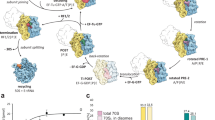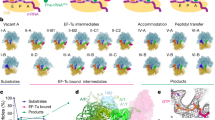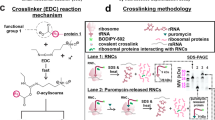Abstract
The ribosome is a molecular machine that translates the genetic code contained in the messenger RNA into an amino acid sequence through repetitive cycles of transfer RNA selection, peptide bond formation and translocation1,2,3. Here we demonstrate an optical tweezer assay to measure the rupture force between a single ribosome complex and mRNA. The rupture force was compared between ribosome complexes assembled on an mRNA with and without a strong Shine–Dalgarno (SD) sequence—a sequence found just upstream of the coding region of bacterial mRNAs, involved in translation initiation4,5. The removal of the SD sequence significantly reduced the rupture force in complexes carrying an aminoacyl tRNA, Phe-tRNAPhe, in the A site, indicating that the SD interactions contribute significantly to the stability of the ribosomal complex on the mRNA before peptide bond formation. In contrast, the presence of a peptidyl tRNA analogue, N-acetyl-Phe-tRNAPhe, in the A site, which mimicked the post-peptidyl transfer state, weakened the rupture force as compared to the complex with Phe-tRNAPhe, and the resultant force was the same for both the SD-containing and SD-deficient mRNAs. These results suggest that formation of the first peptide bond destabilizes the SD interaction, resulting in the weakening of the force with which the ribosome grips an mRNA. This might be an important requirement to facilitate movement of the ribosome along mRNA during the first translocation step.
This is a preview of subscription content, access via your institution
Access options
Subscribe to this journal
Receive 51 print issues and online access
$199.00 per year
only $3.90 per issue
Buy this article
- Purchase on Springer Link
- Instant access to full article PDF
Prices may be subject to local taxes which are calculated during checkout



Similar content being viewed by others
References
Noller, H. F. Structure of ribosomal RNA. Annu. Rev. Biochem. 53, 119–162 (1984)
Wintermeyer, W. et al. Mechanisms of elongation on the ribosome: dynamics of a macromolecular machine. Biochem. Soc. Trans. 32, 733–737 (2004)
Green, R. & Noller, H. F. Ribosomes and translation. Annu. Rev. Biochem. 66, 679–716 (1997)
Shine, J. & Dalgarno, L. The 3′-terminal sequence of Escherichia coli 16S ribosomal RNA: complementarity to nonsense triplets and ribosome binding sites. Proc. Natl Acad. Sci. USA 71, 1342–1346 (1974)
Calogero, R. A., Pon, C. L., Canonaco, M. A. & Gualerzi, C. O. Selection of the mRNA translation initiation region by Escherichia coli ribosomes. Proc. Natl Acad. Sci. USA 85, 6427–6431 (1988)
Yusupov, M. M. et al. Crystal structure of the ribosome at 5.5 Å resolution. Science 292, 883–896 (2001)
Yusupova, G. Z., Yusupov, M. M., Cate, J. H. D. & Noller, H. F. The path of messenger RNA through the ribosome. Cell 106, 233–241 (2001)
Moazed, D. & Noller, H. F. Interaction of tRNA with 23S rRNA in the ribosomal A, P, and E sites. Cell 57, 585–597 (1989)
Moazed, D. & Noller, H. F. Binding of tRNA to the ribosomal A and P sites protects two distinct sets of nucleotides in 16S rRNA. J. Mol. Biol. 211, 135–145 (1990)
Dorywalska, M. et al. Site-specific labeling of the ribosome for single-molecule spectroscopy. Nucleic Acids Res. 33, 182–189 (2005)
van Dijk, M. A., Kapitein, L. C., van Mameren, J., Schmidt, C. F. & Peterman, E. J. G. Combining optical trapping and single-molecule fluorescence spectroscopy: Enhanced photobleaching of fluorophores. J. Phys. Chem. B 108, 6479–6484 (2004)
Blanchard, S. C., Kim, H. D., Gonzalez, R. L., Puglisi, J. D. & Chu, S. tRNA dynamics on the ribosome during translation. Proc. Natl Acad. Sci. USA 101, 12893–12898 (2004)
Semenkov, Y. P., Rodnina, M. V. & Wintermeyer, W. Energetic contribution of tRNA hybrid state formation to translocation catalysis on the ribosome. Nature Struct. Biol. 7, 1027–1031 (2000)
Fredrick, K. & Noller, H. F. Accurate translocation of mRNA by the ribosome requires a peptidyl group or its analog on the tRNA moving into the 30S P site. Mol. Cell 9, 1125–1131 (2002)
Katunin, V. I., Savelsbergh, A., Rodnina, M. V. & Wintermeyer, W. Coupling of GTP hydrolysis by elongation factor G to translocation and factor recycling on the ribosome. Biochemistry (Mosc.) 41, 12806–12812 (2002)
Frank, J. & Agrawal, R. K. A ratchet-like inter-subunit reorganization of the ribosome during translocation. Nature 406, 318–322 (2000)
Acknowledgements
We thank C. Squires for the SQ380 strain that was used to engineer the ribosomes. We are grateful to colleagues in the S. Chu and J. Puglisi groups at Stanford University for encouragement and discussions. S.U. is a recipient of JSPS Postdoctoral Fellowships for Research Abroad. M.D. was supported by the HHMI Predoctoral Fellowship. This work was funded by grants to J.D.P. from the NIH and the Packard Foundation, to S.C. from the NSF and NASA, and to J.D.P. and S.C. from the Packard Foundation.
Author information
Authors and Affiliations
Corresponding authors
Ethics declarations
Competing interests
Reprints and permissions information is available at www.nature.com/reprints. The authors declare no competing financial interests.
Supplementary information
Supplementary Information
This file contains Supplementary Figure S1, Supplementary Methods and additional references. (PDF 438 kb)
Rights and permissions
About this article
Cite this article
Uemura, S., Dorywalska, M., Lee, TH. et al. Peptide bond formation destabilizes Shine–Dalgarno interaction on the ribosome. Nature 446, 454–457 (2007). https://doi.org/10.1038/nature05625
Received:
Accepted:
Issue Date:
DOI: https://doi.org/10.1038/nature05625
This article is cited by
-
A model for ribosome translocation based on the alternated displacement of its subunits
European Biophysics Journal (2023)
-
Assembly and functionality of the ribosome with tethered subunits
Nature Communications (2019)
-
A Novel Method to Evaluate Ribosomal Performance in Cell-Free Protein Synthesis Systems
Scientific Reports (2017)
-
Initiation of mRNA translation in bacteria: structural and dynamic aspects
Cellular and Molecular Life Sciences (2015)
-
The ribosome uses two active mechanisms to unwind messenger RNA during translation
Nature (2011)
Comments
By submitting a comment you agree to abide by our Terms and Community Guidelines. If you find something abusive or that does not comply with our terms or guidelines please flag it as inappropriate.



